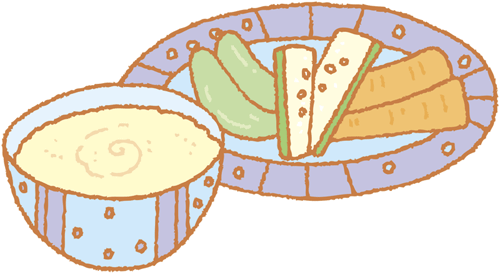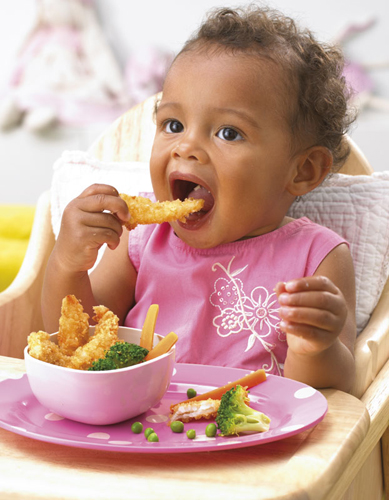|
Finger foods aren’t just snacks or incidental additions to your toddler’s diet. You can supplement even the fussiest toddler’s menu with appealing goodies that will both add nutritional value and encourage her to learn the skills of independent eating.

| Q: |
How can I encourage my child to eat foods with different consistencies?
| | A: |
Some little ones find the transition from purées to lumps, and
then to mashed, chopped, and cut food more difficult than others, and
may be reluctant to eat meals that require chewing. In some cases, it
comes down to laziness, or it may be that weaning took place a little
later than usual.
It is important that
you continue to introduce foods with different textures. One of the best
ways to do this is to offer what is effectively a balanced selection of
finger foods at every meal, so everything he eats must be chewed, with
no purées at all. For example, offer peas, sweet potato cubes, strips of
chicken, and chunks of steamed new potatoes, or rice with fish balls
and steamed broccoli. Many children seem to find it easier to move
straight on to this “real food,” rather than progressing through
different textures.
|
| Q: |
How small should I mash or chop foods for my toddler?
| | A: |
Once your toddler has some teeth, she can manage most soft foods
that have been diced, grated, or mashed. In fact even without teeth it
is surprising what a set of gums can munch their way through. Certainly
by 12 to 18 months, your toddler should be able to enjoy a variety of
different finger foods, which can be incorporated into his regular
meals. As long as the food isn’t too tough, which may be beyond the
capabilities of little teeth and gums, small pieces of most foods can be
managed easily. If your child gags or has trouble managing diced foods,
try making the pieces a little smaller until he’s more adept at
chewing. I often find it useful to whiz tougher cuts of meat in a
grinder for a few seconds, to smooth out some of the lumps and bumps,
and make them a little softer for little ones. Use your ”ground” meats
as a base for any meat dish, including pasta sauces, casseroles, or
dishes such as Chicken meatballs and Funny-face hamburgers.
You can also try increasing the chunks in the foods that he already
loves and is most familiar with, where they will not be so readily
noticed or identified!
|
| Q: |
My toddler still refuses to eat anything with lumps—what can I do?
| | A: |
Some babies and toddlers, particularly those who have been weaned
onto jarred baby foods, tend to like things smooth! They can often
develop the most amazing ability to filter out every single lump and
spit them out. Some little ones simply gag because it’s taken them a
little longer to develop the knack of chewing things well enough to make
them easily swallowed. You should visit your doctor, however, if your
toddler regularly gags or refuses lumps, as there may be a physical
cause at the root.
There are a few ways
you can help your child to accept lumpy food. First of all, don’t force
it. If your toddler senses that you are angry or anxious, he’ll begin to
find the whole experience of eating traumatic, and may literally gag or
choke on even the tiniest lumps because he feels under pressure.
Slowly increase the
lumpiness of his food, and allow him to play messily with it. Babies
and toddlers tend to prefer overall lumpiness to something smooth with
the occasional lump, so pasta stirred into a favorite purée is a good
way to introduce more texture.
Also offer finger foods
alongside his meals. Start with soft foods, such as steamed carrots and
broccoli or avocado, and move on to slightly harder foods, such as
toast fingers and well-cooked pasta shapes, before he’s comfortable with
chewing, when you can introduce cubes of soft cheese, dried apricots,
and chunks of meat, for example.
Once your toddler
starts to experiment a little and becomes more comfortable with lumps,
it’s a good idea to encourage him to stir “lumpy” ingredients into his
foods, such as raisins into cereal, or to dip finger foods into purées.
Over time, all will be well.
|
| Q: |
What are the best finger foods for this age group?
| | A: |
Incorporating as many different food groups as you can will make a
big difference to the number of nutrients your toddler gets. Raw
vegetables, such as carrot sticks, cucumber, or strips of red pepper,
are often more popular than cooked. Try some more unusual vegetables,
too. Crunchy sugar snap peas are delicious—serve them with hummus.
Berries, grapes, mango, apple, and banana are all healthy snacks. You
can also make fresh fruit popsicles by blending fruits together with
fruit juice or yogurt and freezing in mini-popsicle molds—chewing on
something cold will also help relieve your toddler’s sore gums. For
wholesome carbohydrates, choose breadsticks, whole wheat toast fingers,
finger sandwiches, flapjacks, rice cakes, healthy breakfast cereals, and
well-cooked pasta. As long as there is no risk of choking, anything
goes!
|
Finger food dips
Make a dip for dipping
vegetable batons by blending together 41/2oz (125g) cottage cheese, 2
tbsp mayonnaise, a heaping tablespoon ketchup, and a squeeze of lemon
juice. For a more fruity dip, blend together a little cottage cheese
with some sugar, a few drops of vanilla, and some apricot purée.
Fish Goujons
Toddlers can be notoriously fussy about fish, but most like these baby-sized fish fingers made with tender white fish.

15 minutes
4–6 minutes
1/2 cup dry bread crumbs 1/4 cup grated Parmesan cheese 1/4 tsp paprika (optional) Freshly ground black pepper 1 egg 1 tsp water 2 tbsp all-purpose flour 8oz
fresh white fish fillet, such as cod or sole, cut into
little-finger-sized strips (if you are planning to freeze the goujons,
be sure the fish has not previously been frozen) 3–4 tbsp sunflower or olive oil, for frying
Mix together the
bread crumbs, Parmesan, and paprika (if using) and season with pepper.
Spread the crumb mixture out on a large plate.
Beat the egg in a bowl with the water. Spread the flour out on another large plate.
Coat the fish pieces in
the flour, then dip in the egg and coat in the bread crumbs. If planning
to freeze, lay the coated fish goujons on a baking sheet lined with
parchment paper. If cooking immediately, put them on a plate.
Heat the oil in a large
frying pan over moderate heat. Fry the fish goujons until they are
golden and the fish is just cooked through, 2–3 minutes on each side.
Drain on paper towels. Check the temperature before serving.
To freeze (uncooked),
cover the baking sheet with plastic wrap and freeze until the fish is
firm, which will take 2–3 hours, then transfer to a freezer bag or
container. Cook from frozen, adding about 30 seconds per side extra
cooking time.
|